 The spectre of deflation haunts the eurozone economy. Inflation in the 12 months to May 2014 was 0.5%, down from 0.7% to April and well below the target of 2% (see). Price deflation can result in deflation of the whole economy. With the prospect of falling prices, many consumers put off spending, hoping to buy things later at a lower price. This delay in spending deflates aggregate demand and can result in a decline in growth or even negative growth: hardly a welcome prospect as the eurozone still struggles to recover from the long period of recession or sluggish growth that followed the 2007–8 financial crisis.
The spectre of deflation haunts the eurozone economy. Inflation in the 12 months to May 2014 was 0.5%, down from 0.7% to April and well below the target of 2% (see). Price deflation can result in deflation of the whole economy. With the prospect of falling prices, many consumers put off spending, hoping to buy things later at a lower price. This delay in spending deflates aggregate demand and can result in a decline in growth or even negative growth: hardly a welcome prospect as the eurozone still struggles to recover from the long period of recession or sluggish growth that followed the 2007–8 financial crisis.
The ECB is well aware of the problem. Its President, Mario Draghi, has stated on several occasions that the central bank will do whatever it takes to ward off deflation and stimulate recovery. At its monthly meeting on 5 June, the ECB Council acted. It took the following measures (see Mario Draghi’s press conference and the press release):
• The main refinancing rate it charges banks on reverse repos (when using open-market operations) was cut from 0.25% to 0.15%.
• The rate it pays banks for depositing money in the ECB was cut from 0% to –0.1%. In other words, banks would be charged for ‘parking’ money with the ECB rather than lending it.
• It will provide targeted lending to banks (targeted longer-term refinancing operations (TLTROs)), initially of 7% of the total amount of each banks’ loans to the non-financial private sector within the eurozone. This will be provided in two equal amounts, in September and December 2014. These extra loans will be for bank lending to businesses and households (other than for house purchase). The total amount will be some €400 billion. Substantial additional lending will be made available quarterly from March 2016 to June 2016.
• It will make preparations for an asset purchase scheme. Unlike that in the UK, which involves the purchase of government bonds, this will involve the purchase of assets which involve claims on private-sector (non-financial) institutions. Depending on financing arrangements, this could amount to quantitative easing.
 • It will suspend sterilising the extra liquidity that has been injected under the Securities Markets Programme (operated from May 2010 to September 2012), which involved purchasing eurozone countries’ existing bonds on the secondary market. In other words it will stop preventing the securities that have been purchased from increasing money supply. This therefore, for the first time, represents a genuine form of quantitative easing.
• It will suspend sterilising the extra liquidity that has been injected under the Securities Markets Programme (operated from May 2010 to September 2012), which involved purchasing eurozone countries’ existing bonds on the secondary market. In other words it will stop preventing the securities that have been purchased from increasing money supply. This therefore, for the first time, represents a genuine form of quantitative easing.
The question is whether the measures will be enough to stimulate the eurozone economy, prevent deflation and bring inflation back to around 2%. The measures are potentially significant, especially the prospect of quantitative easing – a policy pursued by other main central banks, such as the Fed, the Bank of England and the Bank of Japan. A lot depends on what the ECB does over the coming months.
The following articles consider the ECB’s policy. The first ones were published before the announcement and look at alternatives open to the ECB. The others look at the actual decisions and assess how successful they are likely to be.
Articles published before the announcement
Mario Draghi faces moment of truth as man with power to steady eurozone The Observer, Larry Elliott (1/6/14)
What the ECB will do in June? Draghi spells it out The Economist (26/5/14)
Draghi as Committed as a Central Banker Gets, as Economists Await ECB Stimulus Bloomberg, Alessandro Speciale and Andre Tartar (19/5/14)
ECB’s credit and credibility test BBC News, Robert Peston (2/6/14)
90 ECB decamps to debate monetary fixes Financial Times, Claire Jones (25/5/14)
Speech
Monetary policy in a prolonged period of low inflation ECB, Mario Draghi (26/5/14)
Articles published after the announcement
ECB launches €400bn scheme, seeks to force bank lending Irish Independent (5/6/14)
The ECB’s toolbox BBC News, Linda Yueh (5/6/14)
ECB’s justified action will help but is no panacea for eurozone deflationary ills The Guardian, Larry Elliott (5/6/14)
Why Negative Rates Won’t Work In The Eurozone Forbes, Frances Coppola (4/6/14)
Germany’s fear of QE is what’s stopping us from cracking open the Cava The Telegraph, Roger Bootle (8/6/14)
Data
Euro area economic and financial data ECB
Questions
- Why has the eurozone experienced falling inflation and a growing prospect of negative inflation?
- Explain how the Securities Markets Programme (SMP) worked (check it out on the ECB site). What countries’ bonds were purchased and why?
- What is meant by sterilisation? Why did the ECB sterilise the effects of the assets purchased under the SMP?
- If it is practical for the ECB to set a negative interest rate on the deposit facility for banks, would it be practical to set a negative interest rate for the main refinancing operations or the marginal lending facility? Explain.
- Why has the ECB, up to now, been unwilling to engage in quantitative easing? What has changed?
- Why may the introduction of a negative interest rate on bank deposits in the ECB have only a very small effect on bank lending?
- How much is broad money supply growing in the eurozone? Is this enough or too much? Explain.
- What else could the ECB have done to ward off deflation? Should the ECB have adopted these measures?
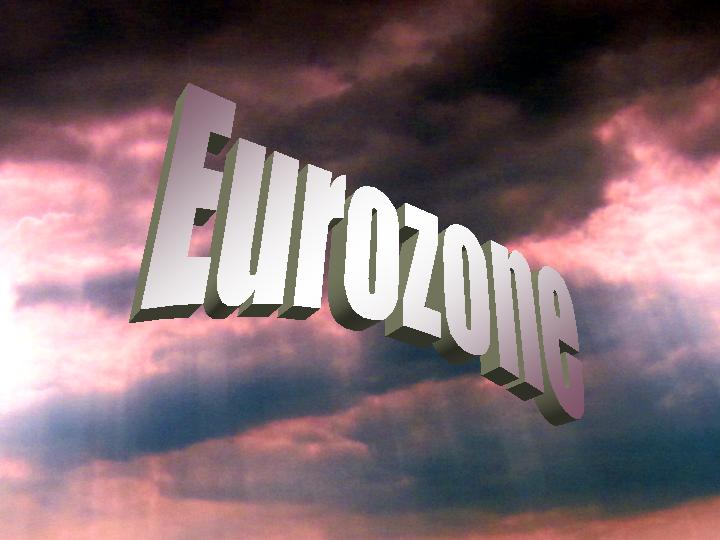 ‘Deflation could be replacing debt as the main problem – and there’s nothing to suggest the ECB is up to the job.’ So begins the linked article below by Barry Eichengreen, Professor of Economics and Political Science at the University of California, Berkeley.
‘Deflation could be replacing debt as the main problem – and there’s nothing to suggest the ECB is up to the job.’ So begins the linked article below by Barry Eichengreen, Professor of Economics and Political Science at the University of California, Berkeley.
The good news in this is that worries about debt in eurozone countries are gradually receding. Indeed, this week Ireland officially ended its reliance on a bailout (of €67.5 billion) from the EU and IMF and regained financial sovereignty (see also).
The bad news is that this does not mark the end of austerity. Indeed, many eurozone countries could get stuck in a deflationary trap, with austerity policies continuing to depress aggregate demand. Eurozone inflation is less than 1% and falling.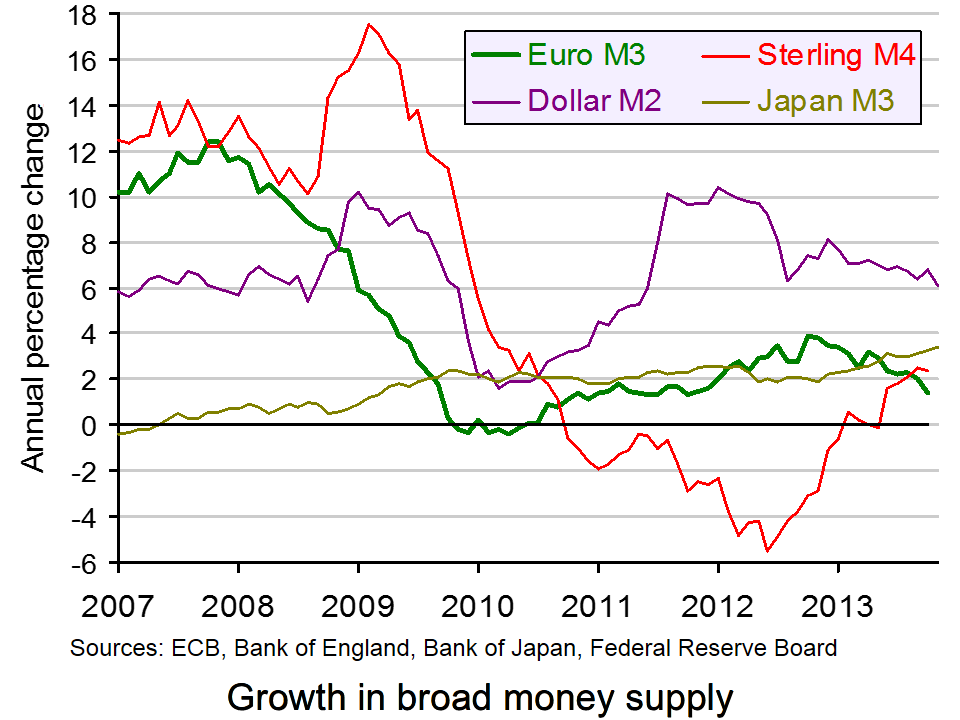 Broad money supply growth is now below that of the US dollar, the yen and sterling (see chart: click here for a PowerPoint).
Broad money supply growth is now below that of the US dollar, the yen and sterling (see chart: click here for a PowerPoint).
The ECB has been far more cautious than central banks in other countries in acting to prevent recession and deflation. Unlike the USA, Japan and the UK, which have all engaged in extensive quantitative easing, the ECB had been reluctant to do so for fear of upsetting German opinion and taking the pressure off southern European countries to reform.
But as Eichengreen points out, the dangers of inaction could be much greater. What is more, quantitative easing is not the only option. The ECB could copy the UK approach of ‘funding for lending’ – not for housing, but for business.
Europe’s economic crisis could be mutating again The Guardian, Barry Eichengreen (10/12/13)
Questions
- What problems are created by falling prices?
- What effect would deflation have on debt and the difficulties in repaying that debt?
- What measures have already been adopted by the ECB to stimulate the eurozone economy? (Search previous articles on this site.)
- Why have such measures proved inadequate?
- What alternative policies are open to the ECB?
- What are the arguments for the ECB being given a higher inflation target (such as 3 or 4%)?
- What are the arguments for and against relaxing fiscal austerity in the eurozone at the current time?
 As we saw in the news item The difficult exit from cheap money, central banks around the world have been operating an extremely loose monetary policy since the beginning of 2009. Their interest rates have been close to zero and trillions of dollars of extra money has been injected into the world economy through various programmes of quantitative easing.
As we saw in the news item The difficult exit from cheap money, central banks around the world have been operating an extremely loose monetary policy since the beginning of 2009. Their interest rates have been close to zero and trillions of dollars of extra money has been injected into the world economy through various programmes of quantitative easing.
For the past few months the Federal Reserve has been purchasing bonds under its most recent programme dubbed QE3, and thereby increasing narrow money, by $85 billion per month. Since the start of its QE programme in 2009, it has pumped around $2.8 trillion of extra money into the US and world economies. This huge increase in money supply has boosted the demand for assets worldwide and world stock markets have risen. Much of the money has flowed into developing countries, such as India, and has acted as a boost to their economies.
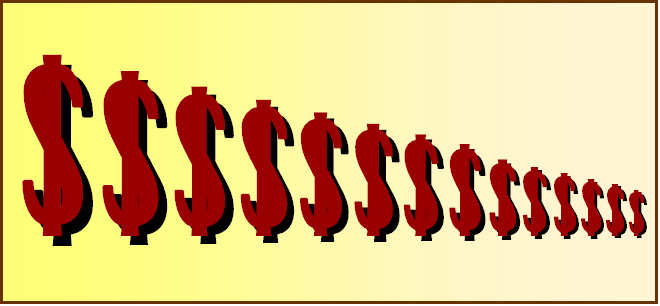 Once the US economy is growing strongly again, the aim is to taper off, and ultimately end or even reverse, the QE programme. It was expected that the Fed would decide to start this tapering off process at its meeting on 18 September – perhaps reducing bond purchases initially by some $10 billion. (Note that this would still be an increase in money supply, just a slightly smaller one.) Over the past few days, US bond prices have been falling (and yields increasing) in anticipation of such a move.
Once the US economy is growing strongly again, the aim is to taper off, and ultimately end or even reverse, the QE programme. It was expected that the Fed would decide to start this tapering off process at its meeting on 18 September – perhaps reducing bond purchases initially by some $10 billion. (Note that this would still be an increase in money supply, just a slightly smaller one.) Over the past few days, US bond prices have been falling (and yields increasing) in anticipation of such a move.
As it turned out, the Fed decided to delay tapering off. It will continue with its assets purchase programme of $85 billion per month for the time being. The reason given was that the US economy was still too fragile and needed the monthly injections of money to stay at the current level.
Normally it might be expected that the announcement of a more fragile recovery would cause the US stock market, and others worldwide, to fall. In fact the opposite occurred, with investors relieved that the extra money, which allows extra asset purchases, would continue at the same rate.
But this then raises the question of just what will be the effect when tapering off does actually occur. Will stock markets then go into a tailspin? Or will they merely stop rising so fast. That depends very much on the role of speculation.
Webcasts
 Bernanke’s Own Words on Asset Purchases, Economy Bloomberg (18/9/13)
Bernanke’s Own Words on Asset Purchases, Economy Bloomberg (18/9/13)
 Bernanke: Fed to delay bond tapering PBS Newshour on YouTube (full speech plus questions) (18/9/13)
Bernanke: Fed to delay bond tapering PBS Newshour on YouTube (full speech plus questions) (18/9/13)
 No tapering announced by Fed CNBC on Yahoo Finance (18/9/113)
No tapering announced by Fed CNBC on Yahoo Finance (18/9/113)
 The impact of US stimulus moves at home and abroad BBC News, Stephanie Flanders (18/9/13)
The impact of US stimulus moves at home and abroad BBC News, Stephanie Flanders (18/9/13)
 Is the upturn reaching Americans? BBC World, Stephanie Flanders (17/9/13)
Is the upturn reaching Americans? BBC World, Stephanie Flanders (17/9/13)
 Shares hit high as Federal Reserve maintains stimulus BBC News, Stephanie Flanders (18/9/13)
Shares hit high as Federal Reserve maintains stimulus BBC News, Stephanie Flanders (18/9/13)
 US Fed decision to delay tapering was a relief ET Now (India), Bimal Jalan (19/9/13)
US Fed decision to delay tapering was a relief ET Now (India), Bimal Jalan (19/9/13)
Articles
Federal Reserve surprises markets by delaying QE tapering The Telegraph, Katherine Rushton (18/9/13)
Federal Reserve delays QE tapering: the full statement The Telegraph (18/9/13)
Q&A: What is tapering? BBC News (18/9/13)
Fed delay is no reason to celebrate The Guardian, Larry Elliott (19/9/13)
Federal Reserve tapering decision has baffled the markets The Guardian, Larry Elliott (19/9/13)
Taper tiger The Economist (21/9/13)
Everything You Need to Know About the Fed’s Decision Not to Taper QE3 The Atlantic, Matthew O’Brien (18/9/13)
Fed’s dovish turn leaves Wall Street economists mulling taper timing: poll Reuters, Chris Reese (18/9/13)
Good news and bad news from the Fed BBC News, Stephanie Flanders (19/9/13)
Is the Fed frightened of its shadow? BBC News, Robert Peston (19/9/13)
The Federal Reserve and Janet Yellen face a tough task with insufficient tools The Guardian, Mohamed A. El-Erian (14/10/13)
Questions
- Why might a slowing down in the increase in US money supply cause asset prices to fall, rather than merely to rise less quickly?
- Why has the US QE programme led to a rise in asset prices overseas?
- Distinguish between stabilising and destabilising speculation. Which type of speculation has been occurring as a result of the US QE programme?
- How has QE affected unemployment in the UK and USA? How is the participation rate and the flexibility of labour markets relevant to the answer?
- Explain the following two statements by Stephanie Flanders and Robert Peston respectively. “The market conditions argument has a circularity to it: talk of tapering leads to higher market rates, which in turn puts the taper itself on hold.” “The Fed simply hinting that less money would be created, means that there will be no reduction in the amount of money created (for now at least).”
- Why have US long-term interest rates, including mortgage rates, risen since May of this year?
- What impact have higher US long-term interest rates had on economies in the developing world? Explain.
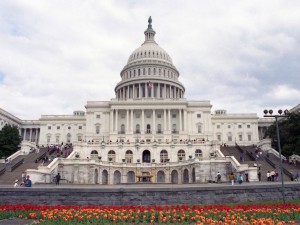 The US Federal Reserve bank has launched a third round of quantitative easing, dubbed QE3. The hope is that the resulting growth in money supply will stimulate spending and thereby increase growth and employment.
The US Federal Reserve bank has launched a third round of quantitative easing, dubbed QE3. The hope is that the resulting growth in money supply will stimulate spending and thereby increase growth and employment.
Ben Bernanke, the Fed Chairman, had already said that the stagnation of the labour market is of grave concern because of “the enormous suffering and waste of human talent it entails, but also because persistently high levels of unemployment will wreak structural damage on our economy that could last for many years”. Not, surprisingly, the markets were expecting strong action – and that is what they got.

Under QE3, the Fed will buy mortgage-backed securities of $40bn per month. And this will go on for as long as it takes for the employment market to show significant improvement. It is this open-ended commitment which makes QE3 different from QE1 and QE2. Under these earlier rounds of quantitative easing, the Fed purchased a fixed amount of assets – $2.3tn of bonds.
QE3 also comes on top of a policy in operation since September 2011 of buying long-term government bonds in the market and selling shorter-dated ones. This ‘funding’ operation is known as ‘Operation Twist’.
The markets responded favourably to the announcement of QE3, especially to the fact that its size and duration would depend on the state of the real economy. Nevertheless, there are real questions about its likely effectiveness. The most important is whether the increase in narrow money will translate into an increase in borrowing and spending and hence an increase in broad money; or whether the rise in narrow money will be offset by a fall in the velocity of circulation as banks seek to increase their liquidity ratios and to recapitalise.
The following articles look at the details of QE3 and whether it is likely to achieve its desired result. Will the Fed be forced to raise asset purchases above $40bn per month or to introduce other measures?
Articles
Federal Reserve to buy more debt to boost US economy BBC News (14/9/12)
Bernanke takes plunge with QE3 Financial Times, Robin Harding (14/9/12)
US monetary policy at an important turning point Financial Times, Gavyn Davies (2/9/12)
Cliffhanger The Economist (22/9/12)
Your flexible Fed BBC News, Stephanie Flanders (13/9/12)
Back Ben Bernanke’s QE3 with a clothes peg on your nose The Telegraph, Ambrose Evans-Pritchard (23/9/12)
QE3 Stimulus from Federal Reserve Drives Mortgage Rates Down to Record Lows TellMeNews, Sharon Wagner (24/9/12)
Helicopter Ben Bernanke: The Problem With QE1, QE2, QE3 and QE Infinity TellMeNews, Martin Hutchinson (18/9/12)
QE: More bang than buck Business Spectator, Stephen Grenville (18/9/12)
QE3: What it Really Means PBS NewsHour, Paul Solman (20/9/12)
US Data
US Money Stock Measures Federal Reserve Statistical Release
Data Releases Board of Governors of the Federal Reserve System
Civilian Unemployment Rate (UNRATE) FRED Economic Data
Questions
- What distinguishes the Fed’s QE3 from its QE1 and 2?
- What will determine the likely success of QE3 in stimulating the real economy?
- Why has there been a huge surge in liquidity preference in the USA? What would have been the impact of this without QE1 and QE2?
- Explain what is meant by ‘portfolio balance effects’ and how significant are these in determining the success of quantitative easing?
- Does QE3 suggest that the Fed is pursuing a type of Taylor Rule?
- Why might QE3 be a “pro-cyclical” blunder?
- To what extent would monetarists approve of the Fed’s policies on QE?
- How is QE3 likely to affect the dollar exchange rate and what implications will this have for countries trading with the USA?
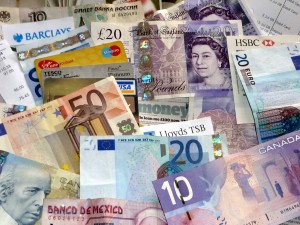 Between December 2007 and March 2009, the Bank of England reduced Bank Rate on several occasions in order to stimulate the economy and combat recession. By March 2009, the rate stood at a record low of 0.5%. Each month the Monetary Policy Committee meets to decide on interest rates and since March 2009, the members’ decision has consistently been that Bank Rate needs to remain at 0.5%.
Between December 2007 and March 2009, the Bank of England reduced Bank Rate on several occasions in order to stimulate the economy and combat recession. By March 2009, the rate stood at a record low of 0.5%. Each month the Monetary Policy Committee meets to decide on interest rates and since March 2009, the members’ decision has consistently been that Bank Rate needs to remain at 0.5%.
Although the UK economy has been making tentative steps towards recovery, it is still in a very vulnerable state. Last month, the Bank of England extended its programme of quantitative easing to a total £325bn stimulus. This, together with the decision to keep interest rates down and with the shock fall in manufacturing output contributing towards first quarter growth of just 0.1%, is a key indication that the UK economy is still struggling, even though the central bank thinks it unlikely that the UK will re-enter recession this year.
Monetary policy in the UK has been very much geared towards stimulating economic growth, despite interest rates typically being the main tool to keep inflation on target at 2%. The problem facing the central bank is that economic growth and inflation are in something of a conflict. Low interest rates to stimulate economic growth also create a higher inflation environment and that is the trade-off the economy has faced. Inflation has been well above its target for some months (a high of 5.2% in September 2011), and the low interest rate environment has done little to deflate the figure. After all, low interest rates are a monetary instrument that can be used to boost aggregate demand, which can then create demand-pull inflation. However, inflation is now slowly beginning to fall, but this downward trend could be reversed with the sky high oil prices we are recently experiencing. If inflation does begin to creep back up, the Monetary Policy Committee will once again face a decision: keep Bank Rate low and continue with quantitative easing to stimulate the economy or increase Bank Rate to counter the higher rate of inflation.
The data over recent months has been truly inconsistent. Some indicators suggest improvements in the economy and the financial environment, whereas others indicate an economic situation that is moving very quickly in the wrong direction. A key factor is that the direction the UK economy takes is very much dependent on the world economy and, in particular, on how events in the eurozone unfold. The following articles consider some of the latest economic developments.
UK economy grew 0.1% to avoid recession, says NIESR Guardian, Katie Allen (5/4/12)
UK interest rates held at 0.5% BBC News (5/4/12)
UK just about avoided recession in Q1, NIESR says Telegraph, Angela Monaghan (5/4/12)
Bank of England keeps interest rates on hold at 0.5pc Telegraph (5/4/12)
UK economy ‘weak but showing signs of improvement’ BBC News (3/4/12)
Bank of England holds on quantitative easing and interest rates Guardian, Katie Allen (5/4/12)
Faith on Tories on economy hits new low Financial Times, Helen Warrell (6/4/12)
Questions
- Which factors will the Monetary Policy Committee consider when setting interest rates?
- Using a diagram to help your answer, illustrate and explain the trade-off that the MPC faces when choosing to keep interest rates low or raise them.
- What is quantitative easing? How is it expected to boost economic growth in the UK?
- Which factors are likely to have contributed towards the low growth rate the UK economy experienced in the first quarter of 2012?
- Explain the trends that we have seen in UK inflation over the past year. What factors have caused the figure to increase to a high in September and then fall back down?
- What do you expect to happen to inflation over the next few months? To what extent is your answer dependent on the MPC’s interest rate decisions?
- Although the official figures suggest that the UK avoided a double-dip recession, do you agree with this assessment? Explain your answer.
 The spectre of deflation haunts the eurozone economy. Inflation in the 12 months to May 2014 was 0.5%, down from 0.7% to April and well below the target of 2% (see). Price deflation can result in deflation of the whole economy. With the prospect of falling prices, many consumers put off spending, hoping to buy things later at a lower price. This delay in spending deflates aggregate demand and can result in a decline in growth or even negative growth: hardly a welcome prospect as the eurozone still struggles to recover from the long period of recession or sluggish growth that followed the 2007–8 financial crisis.
The spectre of deflation haunts the eurozone economy. Inflation in the 12 months to May 2014 was 0.5%, down from 0.7% to April and well below the target of 2% (see). Price deflation can result in deflation of the whole economy. With the prospect of falling prices, many consumers put off spending, hoping to buy things later at a lower price. This delay in spending deflates aggregate demand and can result in a decline in growth or even negative growth: hardly a welcome prospect as the eurozone still struggles to recover from the long period of recession or sluggish growth that followed the 2007–8 financial crisis.• It will suspend sterilising the extra liquidity that has been injected under the Securities Markets Programme (operated from May 2010 to September 2012), which involved purchasing eurozone countries’ existing bonds on the secondary market. In other words it will stop preventing the securities that have been purchased from increasing money supply. This therefore, for the first time, represents a genuine form of quantitative easing.







